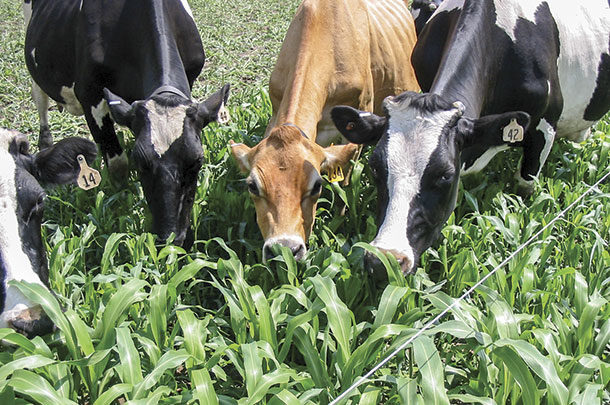“Sorghum is a very versatile crop, there is a lot you can do with it,” Larry Richardson of Richardson Seed in Amarillo, Texas, says. “It can survive well with less water and no fertilizer than alfalfa and has great drought resistance – that is one of its strong suits. It is from Africa and does well in lower-nutrient soils with lower rainfall.”
Richardson Seed sells a lot of sorghum – over 30 million pounds per year, and he has found that it makes for good management no matter how it is grown or for what purpose.
“You plant it and grow it; you can graze it in a rotational pattern, or you can bale it or even feed it off the stump in the wintertime,” Richardson says.
Ideally, the sorghum is planted in June in Texas, or whenever the soil reaches roughly 60ºF. Cattlemen turn their cows out on it about 50 to 60 days later and can continue grazing it for the next 90 to 120 days or until the first hard frost – sometimes until late October in his area.
“We figure it can carry one 400-pound calf per acre but that can vary on conditions in each field,” Richardson says.
Logan Girardin is with Arrow Seed out of Broken Bow, Nebraska, and the estimate they use is a lot higher, but that can also be attributed to differences in growing conditions in their state.
“We figure about three to five animal units per acre in our area,” Girardin says. “If you are cutting it or chopping it, you will harvest between 4.5 ton and 6 ton per acre.” The growing season in Nebraska is shorter than in Texas, but they still plant near the end of May or early June, growing it out until late August.
“Quite a few farmers raise it around here,” Girardin says. “They count on it, especially for additional feed during a drought year like we are getting this year. It’s good summer pasture and produces a good hay crop, especially in drought years – that is what it is bred for.”
Josh Baker, marketing manager of South East Agriseed, says that in Georgia, sorghum is the go-to feed when growers want to beat the heat while still providing nutritious, digestible forage in 90ºF weather.
“It’s just another tool in the tool chest,” Baker says. “Sorghum does a very good job giving us high-quality forage.”
While sorghum makes an excellent crop during drought years, too little moisture can cause stress on the plant, which in turn causes heavy prussic acid buildup that can be deadly in cattle.
Don Kinkhorst is the national sales manager for Allied Seed and says that prussic acid can be a problem when the plant receives too little water, is under stress or receives too much nitrogen, although it usually is more concentrated in the lower part of the plant.
“If it is too dry, you can have problems, even though it is very drought-tolerant,” Kinkhorst says. “It’s a pretty neat crop. I normally recommend growers keep an eye on their prussic acid levels if they have had problems with that before, or if they are growing it in an area that has high nitrates, or where there is severe drought.”
He says when the plant is stressed or doesn’t receive enough moisture during the summer, the higher nitrates may be a problem, as well as prussic acid.
“That’s usually not the case, but I have seen it before,” Kinkhorst says. “You just have to watch out for it and if you think it will be a problem, then test the nitrate and prussic acid levels first, prior to grazing.”
Even if the sorghum is showing high nitrates or higher prussic acid, there are ways around it. One method is to wait until the field gets moisture and starts growing again, at which point you could cut it or chop it a little higher up on the stalk as those levels will be concentrated in the lower parts of the plant. Or simply wait a week for the nitrate and prussic acid levels to regulate and continue grazing it.
Prussic acid will also be higher in the plant after the first freeze, but growers can simply wait to feed or chop it for a week and then resume feeding it to avoid the effects.
There are really a lot of advantages to growing sorghum. It grows better than corn in heavy clay soil, and in drought conditions, will outperform corn every time. It grows well in marginal soil and seldom needs herbicides of any type. It doesn’t need any pesticides, which some growers attribute to the prussic acid. It can be grown out and cut multiple times throughout the year and produces good-quality feed with minimal input.
Growers have also attributed sorghum with excellent erosion control as it is fast growing and has a fine root system that holds soil in place better than counterparts, and especially better than corn.
Growers especially like the fact there isn’t a hard and fast rule when to use or harvest sorghum as it will maintain its quality throughout the growing season; so, if a farmer is working around corn, barley, wheat or potato harvests, the sorghum will wait until there is time to deal with it or just let the cows take care of it in the field.
“Cows really like it,” Richardson says. “It has 85 to 90 percent of the nutrients that alfalfa has and can survive well with less water and fertilizer than alfalfa requires. It just makes great management sense, but then I guess that also depends on what a grower wants to do with their cattle. You can always choose to just plant it and grow it and use it as winter hay on the stalk.” ![]()
PHOTO: It grows well in marginal soil and seldom needs herbicides of any type. It doesn’t need any pesticides, which some growers attribute to the prussic acid. Photo courtesy of Southeast Agriseed.
Becky Cook is a freelance writer based in Idaho.










